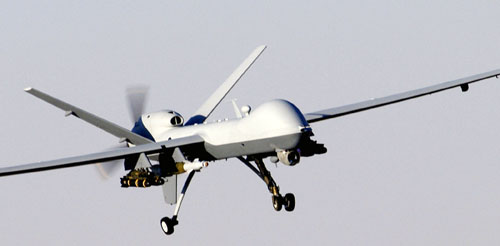The latest skill required in the war on terror? direct messaging
The Los Angeles times has a terrifyingfascinating reconstruction of a US airstrike that killed 23 (or 16 if you believe the US military) afghan civilians on 21 february 2010. The reconstruction focusses on the role played by the pilot and camera operator of a predator drone that observed three ‘suspicious’ vehicles whose passengers had the misfortune crossing paths with a team of US special operators early on February the 21st.

MQ-9 Reaper in flight
The article documents how the drone operators (in Nevada), the the commander of the Special operations team (on the ground in Afghanistan) and a team of video screeners (in Florida) interacted in falsely determining that the Afghanis were armed insurgents (in reality they were unarmed villagers). One of the most intresting aspects of the article is the insight it provides into the communication patterns between the different actors involved on the US side:
The Predator’s two-man team — a pilot and a camera operator — was one of the Air Force’s most-experienced. […] Also stationed at Creech were the Predator’s mission intelligence coordinator and a safety observer. In addition, a team of “screeners” — enlisted personnel trained in video analysis — was on duty at Air Force special operations headquarters in Okaloosa, Fla. They sat in a large room with high-definition televisions showing live feeds from drones flying over Afghanistan. The screeners were sending instant messages to the drone crew, observations that were then relayed by radio to the A-Team. On the ground, the A-Team was led by an Army captain, a veteran of multiple tours in Afghanistan. Under U.S. military rules, the captain, as the ground force commander, was responsible for deciding whether to order an airstrike.
So you have a ground commander who cant see the the target who is in radio contact with the drone operator who gets most of the image analysis provided by screeners in another state who provide their assessments via direct messages and emails containing image stills) but without having access to the radio traffic with the ground commander.
As it turns out this is about as much a recipe for disaster as it sounds… [read the full article here]
